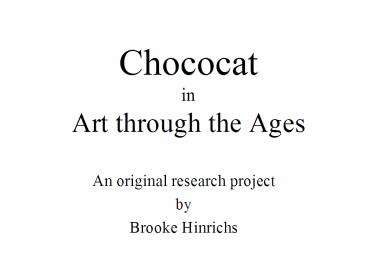Chococat in Art through the Ages PowerPoint PPT Presentation
1 / 13
Title: Chococat in Art through the Ages
1
ChococatinArt through the Ages
- An original research project
- by
- Brooke Hinrichs
2
Prehistoric Age
Here we see the earliest known appearance of the
ubiquitous Chococat image. Dating from the
prehistoric age, approximately 30,000-25,000 BCE
this small limestone statue is known as the
Chococat of Willendorf. From the exaggerated
sexual characteristics, it is theorized that this
was a fertility goddess or charm.
3
Ancient Age--Egypt
This Egyptian papyrus dates from about 332-30
BCE, roughly the Ptolmaic period. This section
of the Book of the Dead shows Osirus judging the
newly deceased. The mans heart is placed on the
scales and weighed against a feather. Chococat
stands by to eat the deceased and his heart in
case he fails the test. Egypt is one of the few
cultures that uses the Chococat image as an evil
or frightening creature most examples of
Chococat found thus far portray him/her as a
neutral or even benevolent being.
4
Ancient Age--Greece
Shown here is the Seated Chococat, a Greek
bronze dating 100-50 BCE. This Hellenistic
figures differs from other works of the period in
its simple, unexaggerated pose and demeanor. The
use of reflected light to give an impression of
Chococats typically wide eyes proves that this
is the work of a master. Other materials were
used to tint the nose of the figure, again in
keeping with traditional representations of
Chococat. Unfortunately, significant
deterioration of the figures head has given it a
somewhat mottled appearance.
5
The Middle Ages
Breviary of Martin of Aragon is the name of
this manuscript, dating from fifteenth century
Spain. This page in particular is the July
calendar page and shows St. Paul addressing the
Colossians on the left, the zodiac sign for Leo
in the middle, and the Apostles Creed, St
Bartholomew and the prophet Micah on the right.
Chococat appears in a window holding a flag this
figure similarly appears in each of the calendar
pages. The significance Chococat in this setting
is unclear, although some postulate that the
illuminator of these pages used the figure as a
sort of signature for his or her work.
6
Northern Renaissance
This engraving was done by Albrect Durer in 1493.
It is called Witch Riding a Ram Backwards.
Portrayals of witches and demons are common to
the engravings of Durer, but this includes an
unusual detail, not found in any of Durers other
works. In the upper left corner, Durer included
Chococats raining from heaven, a common symbolic
convention of this time period.
7
Italian Renaissance
Most people are familiar with Botticellis
painting The Birth of Venus(1480). Recently
discovered, however, is this Birth of Chococat.
It is unknown which painting was done first,
although many scholars now believe one of
Botticellis students did the Venus painting, and
copying from the great masters Chococat painting.
8
Baroque Period
This painting is called Aristotle contemplating
the bust of Chococat. Presumably it was done by
Rembrandt in 1653, although there has been some
conflict about that. The Rembrandt Convention,
which is reexamining all painting attributed to
Rembrandt, has put this painting on their maybe
list.
9
19th Century--Impressionism
Here we have an Impressionist painting by Claude
Monet called Chococat by the Seine at
Argenteuil. The style of the painting implies
it was done in the 1870s Monets earlier works
showed detail more clearly, while his late works
lost the sense of detail (and sometimes subject
matter altogether) and became studies of color.
The Seine was a popular subject for most of the
Impressionist painters.
10
19th Century--Pointillism
George Seurat made his name in art by taking the
study of color relations used in Impressionism a
step further he took strokes of color and
turned them into small dots, or points, of color.
This painting is a prime example of his style,
which was called Pointillism and was copied by
many other artists. It is called Portrait of
Chococat and was done in 1889.
11
20th Century
Although this painting is more curvilinear that
his other paintings, its attribution to Pablo
Picasso is widely accepted. It is called simply
Chococat and was completed in 1925. It is
atypical of the Cubist style because of its
smooth flowing lines and its lack of geometric
components .
12
20th Century
Andy Warhol is one of the most famous artists of
the twentieth century, known for his unusual
portraits of famous people. It is only fitting
that he should choose for a subject one of the
most famous figures of our, and indeed all,
times, namely Chococat. This small portrait was
done in 1963.
13
(No Transcript)

